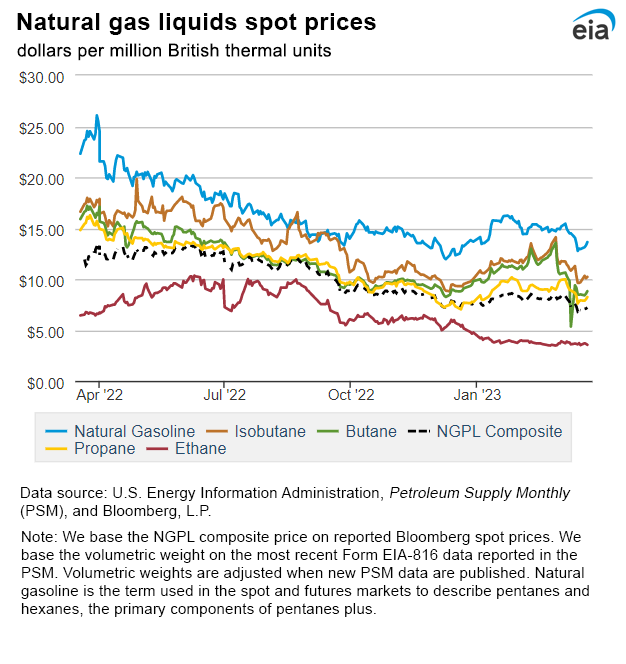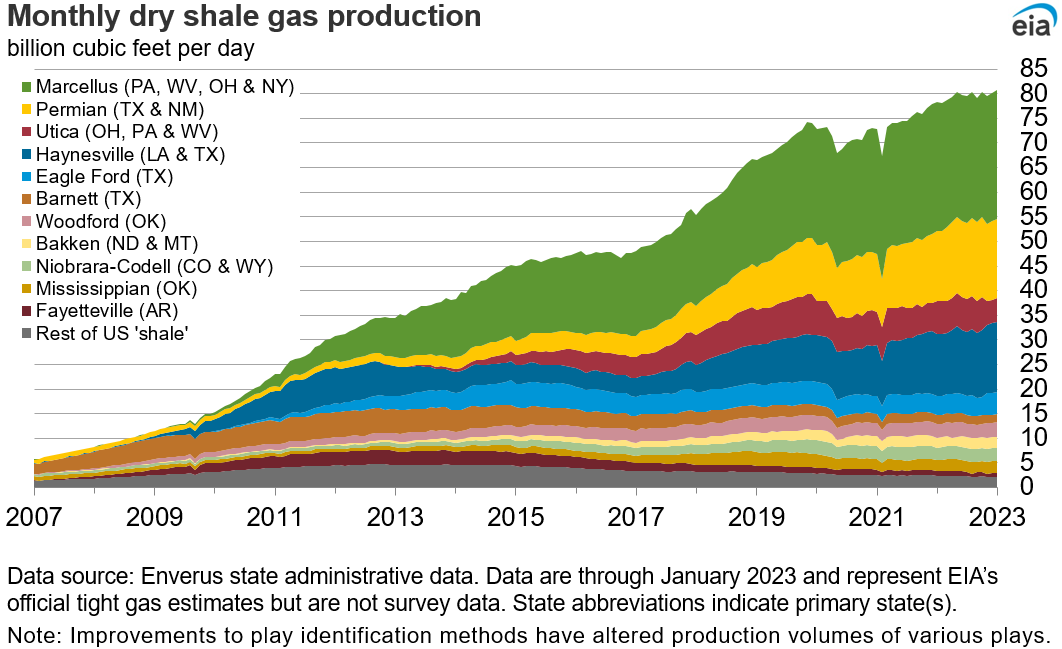In the News:
U.S. natural gas consumption reaches five-year lows in January and February 2023
U.S. natural gas consumption in both January and February reached its lowest levels since 2018, averaging 104.4 billion cubic feet per day (Bcf/d) in January 2023 and 103.0 Bcf/d in February 2023, according to our Short-Term Energy Outlook (STEO). Consumption in January was 10% lower than in January 2022 and 5% lower than the five-year (2018–2022) average for January. February natural gas consumption was 6% lower than in February 2022 and 3% lower than the five-year average for February.
Natural gas consumption in the residential and commercial sectors, which was 18% lower in January and 12% lower in February than in the same months in 2022, drove the decrease in overall natural gas consumption. Consumption was low because of above-average temperatures in those months, particularly in the regions where natural gas consumption makes up a large share of fuel used for space heating.
January 2023 had 22% fewer heating degree days (HDDs) than January 2022 and 16% fewer HDDs than the five-year January average. The decrease from January 2022 to January 2023 was greater partly because January 2022 was colder than normal and resulted in 12% more HDDs than the five-year (2017–2021) January average. Mild weather continued in February this year, leading to 13% fewer HDDs than in February 2022 and 12% fewer HDDs than the five-year February average.
Fewer HDDs at the beginning of 2023 led to lower natural gas consumption in the residential and commercial sectors in the U.S. Midwest and Northeast, where natural gas accounts for the highest percentage of heating fuel.
In the Midwest region, natural gas consumed in the residential and commercial sectors averaged 10.8 Bcf/d in January 2023 and 10.5 Bcf/d in February 2023, according to data from S&P Global Commodity Insights. The residential and commercial sectors consumed 20% less natural gas in the first two months of 2023 than in the same period in 2022 and 16% less than the five-year average for the two months combined.
Similarly, in the Northeast region, natural gas consumed in the residential and commercial sectors averaged 12.7 Bcf/d in January and 12.8 Bcf/d in February 2023. The residential and commercial sectors consumed 23% less natural gas in the first two months of 2023 than in the same period in 2022 and 22% less than the five-year average for the two months combined.
In the Western region, natural gas consumption in the residential and commercial sectors in January and February 2023 averaged 2% less than in January and February 2022 and 1% less than the five-year average for the two months combined. Although the region experienced one of the coldest winters in years, it relies less on natural gas for space heating than the Midwest and Northeast. In contrast, changes in weather have a greater affect on electricity generation in the region. Natural gas consumption in the electric power sector was 23% higher in the first two months of this year than in January and February 2022 and 33% higher than the five-year average for the two months combined.
Market Highlights:
(For the week ending Wednesday, March 22, 2023)Prices
- Henry Hub spot price: The Henry Hub spot price fell 40 cents from $2.44 per million British thermal units (MMBtu) last Wednesday to $2.04/MMBtu yesterday.
- Henry Hub futures prices: The price of the April 2023 NYMEX contract decreased 26.8 cents, from $2.439/MMBtu last Wednesday to $2.171/MMBtu yesterday. The price of the 12-month strip averaging April 2023 through March 2024 futures contracts declined 13.3 cents to $3.046/MMBtu.
- Select regional spot prices: Natural gas spot prices fell at most locations this report week (Wednesday, March 15, to Wednesday, March 22). Week-over-week price changes at major pricing hubs ranged from a decrease of $2.63/MMBtu at Opal in Southwest Wyoming to an increase of $2.32/MMBtu at PG&E Citygate in Northern California.
- Prices in California rose this report week, as below-normal temperatures across the West persisted. Even as prices in the West broadly declined, the price at PG&E Citygate in Northern California increased $2.32, up from $6.94/MMBtu last Wednesday to $9.26/MMBtu yesterday. Further south, the price at SoCal Citygate in Southern California increased $2.27 from $7.51/MMBtu last Wednesday to $9.78/MMBtu yesterday. In the Sacramento Area, temperatures averaged 54°F this report week, 2°F below normal, while temperatures in the Riverside Area, east of Los Angeles, averaged 56°F, 4°F below normal. SoCalGas has not updated its notice regarding Line 235 remediation, which has caused operating capacity from the California-Arizona border into the Los Angeles Basin to be reduced by up to 0.8 billion cubic feet per day (Bcf/d) since mid-February. El Paso Natural Gas (EPNG) issued a notice of ongoing maintenance on its North Mainline through the end of March, reducing westbound flows from the Permian and Rocky Mountain producing regions to California by almost 0.5 Bcf/d. This maintenance is planned to continue through April, and EPNG expects reductions in operating capacity to reach almost 1.0 Bcf/d in late April. In addition, PG&E is reporting pipeline maintenance on the Redwood Path at Devlan Station, reducing southbound flows from Malin, Oregon, into the PG&E service territory in Northern California by nearly 0.7 Bcf/d.
- Prices along the Gulf Coast fell this report week, in line with the price at the Henry Hub, even as temperatures fell to below-normal levels across much of the region midweek. The price at the Waha Hub in West Texas, which is located near Permian Basin production activities, fell 36 cents this report week, from $1.27/MMBtu last Wednesday to $0.91/MMBtu yesterday. In South Texas, natural gas consumption in the combined residential and commercial sectors increased by 57% (0.2 Bcf/d) week over week, according to data from S&P Global Commodity Insights. Temperatures in the Houston Area averaged 59°F this week, which is 5°F below normal. On Monday, temperatures in the Houston Area averaged 47°F, resulting in 18 heating degree days (HDDs), a measure of heating demand, but yesterday they averaged 76°F, resulting in 11 cooling degree days (CDDs), a measure of air-conditioning demand.
- International futures prices: International natural gas futures prices decreased this report week. According to Bloomberg Finance, L.P., weekly average front-month futures prices for liquefied natural gas (LNG) cargoes in East Asia fell 98 cents to a weekly average of $13.24/MMBtu. Natural gas futures for delivery at the Title Transfer Facility (TTF) in the Netherlands fell $1.43 to a weekly average of $13.14/MMBtu. In the same week last year (week ending March 23, 2022), the prices were $34.83/MMBtu in East Asia and $33.81/MMBtu at TTF.
- Natural gas plant liquids (NGPL) prices: The natural gas plant liquids composite price at Mont Belvieu, Texas, fell by 30 cents/MMBtu, averaging $7.06/MMBtu for the week ending March 22. Ethane prices fell 1%, while natural gas prices at the Houston Ship Channel fell 13% week over week, widening the ethane premium to natural gas by 18%. Ethylene spot prices rose 1%, widening the ethylene to ethane premium by 2%. The Brent crude oil price fell 7%, while propane prices fell 6%, resulting in a 10% decrease in the propane discount relative to crude oil. Normal butane prices rose 1%, while isobutane prices fell 6%. The natural gasoline price fell 5%.
Daily spot prices by region are available on the EIA website.
Supply and Demand
- Supply: According to data from S&P Global Commodity Insights, the average total supply of natural gas fell by 0.2% (0.2 Bcf/d) compared with the previous report week. Dry natural gas production decreased by 0.2% (0.2 Bcf/d) to a weekly average of 100.9 Bcf/d, and average net imports from Canada remained relatively unchanged for the week at 4.7 Bcf/d.
- Demand: Total U.S. consumption of natural gas fell by 4.3% (3.9 Bcf/d) compared with the previous report week to a weekly average of 85.9 Bcf/d, according to data from S&P Global Commodity Insights. Natural gas consumed for power generation declined by 5.4% (1.7 Bcf/d) week over week, while industrial sector consumption decreased by 0.8% (0.2 Bcf/d) week over week. In the residential and commercial sectors, consumption declined by 5.8% (2.0 Bcf/d). Natural gas exports to Mexico decreased 4.5% (0.2 Bcf/d) to 5.2 Bcf/d. Natural gas deliveries to U.S. LNG export facilities (LNG pipeline receipts) averaged 13.0 Bcf/d, or 0.2 Bcf/d lower than last week.
Liquefied Natural Gas (LNG)
- Pipeline receipts: Overall natural gas deliveries to U.S. LNG export terminals decreased by 1.3% (0.2 Bcf/d) week over week to 13.0 Bcf/d, according to data from S&P Global Commodity Insights. Natural gas deliveries to terminals in South Louisiana decreased by 3.5% (0.3 Bcf/d) to 8.4 Bcf/d, while deliveries to South Texas terminals increased by 4.4% (0.1 Bcf/d) to 3.4 Bcf/d. Natural gas deliveries to terminals along the East Coast were essentially unchanged.
- Vessels departing U.S. ports: Twenty-seven LNG vessels (10 from Sabine Pass; 5 from Cameron; 4 each from Corpus Christi and Freeport; and 2 each from Calcasieu Pass and Cove Point) with a combined LNG-carrying capacity of 100 Bcf departed the United States between March 16 and March 22, according to shipping data provided by Bloomberg Finance, L.P.
- U.S. LNG export terminals:Natural gas pipeline deliveries to the Freeport LNG export terminal on Quintana Island, near Freeport, Texas, averaged approximately 655 million cubic feet per day (MMcf/d) this report week, 205 MMcf/d above last week's average and 36% of the terminal's full feed gas capacity, according to Gulf South Pipeline, the main delivery pipeline to the terminal.
Rig Count
- According to Baker Hughes, for the week ending Tuesday, March 14, the natural gas rig count increased by 9 rigs from a week ago to 162 rigs. Four rigs were dropped in the Utica, while five rigs were added in the Marcellus, four rigs were added in the Eagle Ford, one rig was added in the Permian, and three rigs were added in unidentified basins. The number of oil-directed rigs decreased by 1 from a week ago to 589 rigs. Six rigs were dropped in the Eagle Ford, and two rigs were dropped in unidentified basins; six rigs were added in the Permian, and one rig was added in the DJ-Niobrara. The total rig count, which includes 3 miscellaneous rigs, stands at 754 rigs, which is 91 more rigs than last year at this time.
Storage
- Net withdrawals from storage totaled 72 Bcf for the week ending March 17, compared with the five-year (2018–2022) average net withdrawals of 45 Bcf and last year's net withdrawals of 55 Bcf during the same week. Working natural gas stocks totaled 1,900 Bcf, which is 351 Bcf (23%) more than the five-year average and 504 Bcf (36%) more than last year at this time.
- According to The Desk survey of natural gas analysts, estimates of the weekly net change to working natural gas stocks ranged from net withdrawals of 67 Bcf to 81 Bcf, with a median estimate of 75 Bcf.
- The average rate of withdrawals from storage is 22% lower than the five-year average so far in the withdrawal season (November through March). If the rate of withdrawals from storage matched the five-year average of 1.2 Bcf/d for the remainder of the withdrawal season, the total inventory would be 1,883 Bcf on March 31, which is 351 Bcf higher than the five-year average of 1,532 Bcf for that time of year.
See also:
Top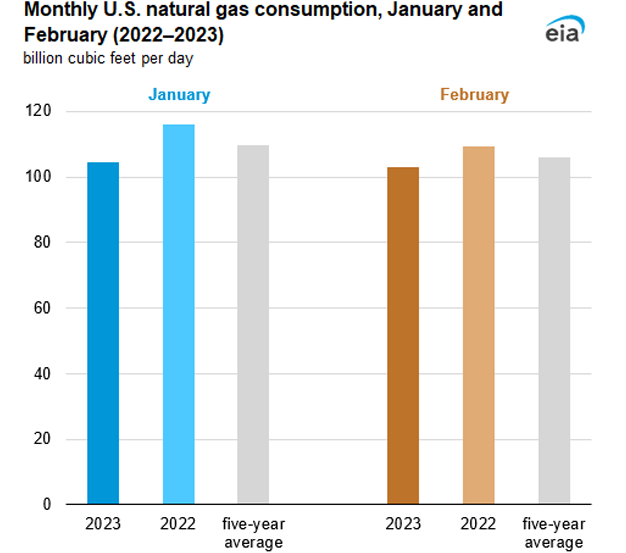
Data source: U.S. Energy Information Administration, Short-Term Energy Outlook
Note: Five-year average=January 2018–2022; February 2018–2022. Natural gas consumption in January and February 2023 are STEO estimates.
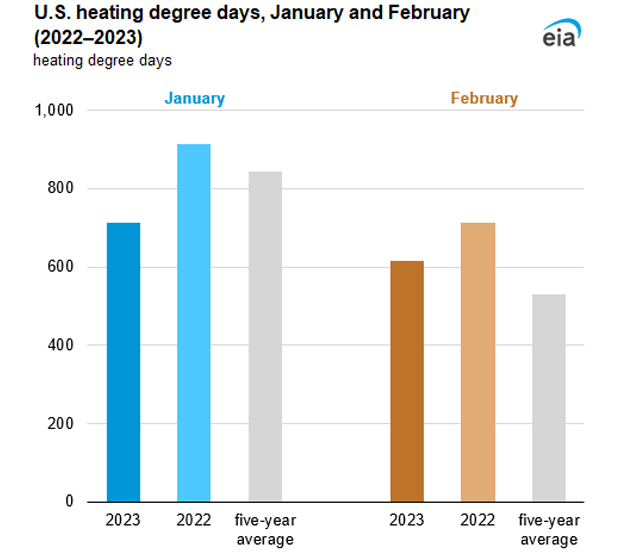
Data source: U.S. Energy Information Administration, Short-Term Energy Outlook
Five-year average=January 2018–2022; February 2018–2022
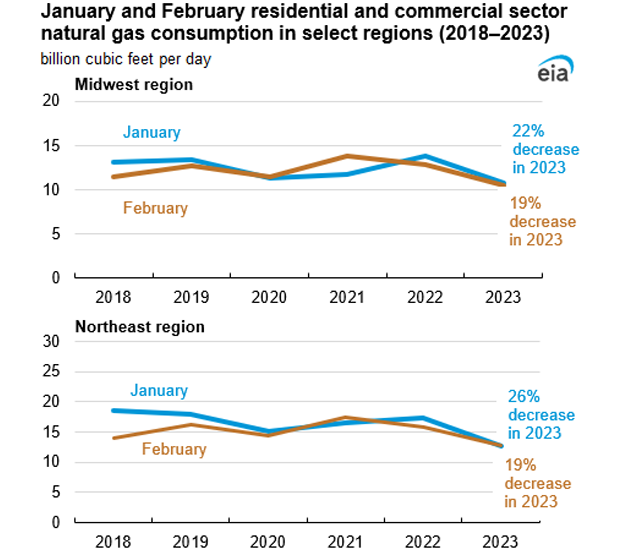
Data source: S&P Global Commodity Insights
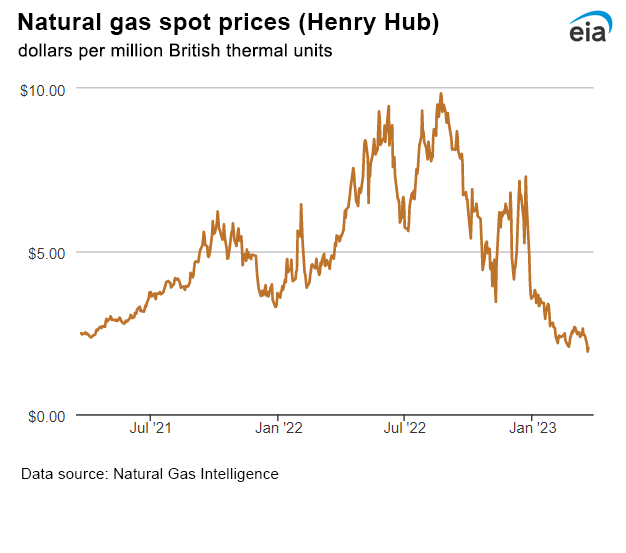
| Spot Prices ($/MMBtu) | Thu, 16-Mar |
Fri, 17-Mar |
Mon, 20-Mar |
Tue, 21-Mar |
Wed, 22-Mar |
|---|---|---|---|---|---|
| Henry Hub |
2.45 |
2.41 |
2.17 |
1.93 |
2.04 |
| New York |
2.19 |
2.33 |
2.00 |
1.81 |
1.83 |
| Chicago |
2.51 |
2.38 |
2.19 |
2.05 |
2.16 |
| Cal. Comp. Avg.* |
5.16 |
4.76 |
6.34 |
5.72 |
5.53 |
| Futures ($/MMBtu) | |||||
| April contract | 2.514 |
2.338 |
2.223 |
2.348 |
2.171 |
| May contract |
2.626 |
2.446 |
2.331 |
2.485 |
2.307 |
| *Avg. of NGI's reported prices for: Malin, PG&E Citygate, and Southern California Border Avg. | |||||
| Source: NGI's Daily Gas Price Index | |||||
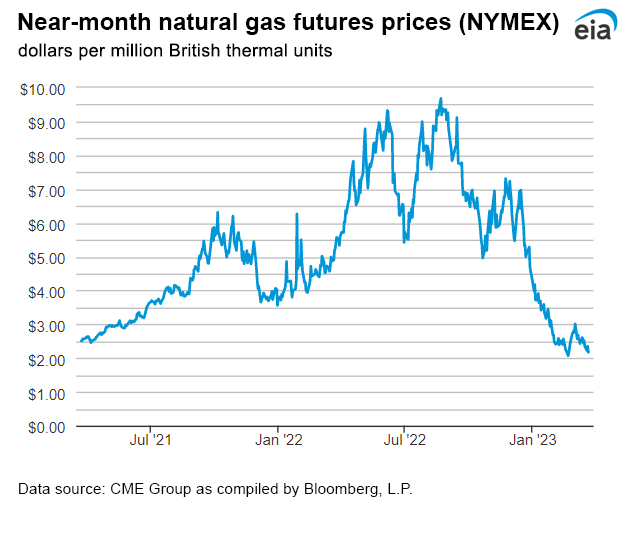
| U.S. natural gas supply - Gas Week: (3/16/23 - 3/22/23) | |||
|---|---|---|---|
Average daily values (billion cubic feet) |
|||
this week |
last week |
last year |
|
| Marketed production | 113.3 |
113.4 |
107.7 |
| Dry production | 100.9 |
101.0 |
95.0 |
| Net Canada imports | 4.7 |
4.7 |
4.3 |
| LNG pipeline deliveries | 0.1 |
0.1 |
0.1 |
| Total supply | 105.7 |
105.9 |
99.4 |
|
Data source: S&P Global Commodity Insights | |||
| U.S. natural gas consumption - Gas Week: (3/16/23 - 3/22/23) | |||
|---|---|---|---|
Average daily values (billion cubic feet) |
|||
this week |
last week |
last year |
|
| U.S. consumption | 85.9 |
89.8 |
70.0 |
| Power | 28.9 |
30.6 |
23.5 |
| Industrial | 23.9 |
24.0 |
23.3 |
| Residential/commercial | 33.1 |
35.1 |
23.3 |
| Mexico exports | 5.2 |
5.4 |
5.3 |
| Pipeline fuel use/losses | 7.3 |
7.4 |
6.6 |
| LNG pipeline receipts | 13.0 |
13.1 |
12.8 |
| Total demand | 111.4 |
115.7 |
94.7 |
|
Data source: S&P Global Commodity Insights | |||
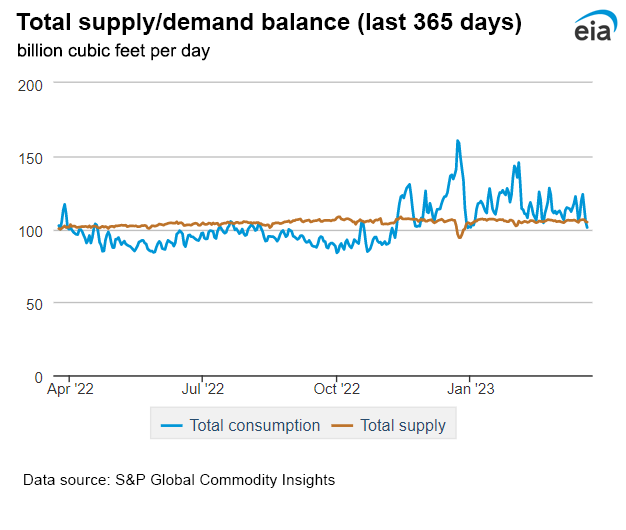
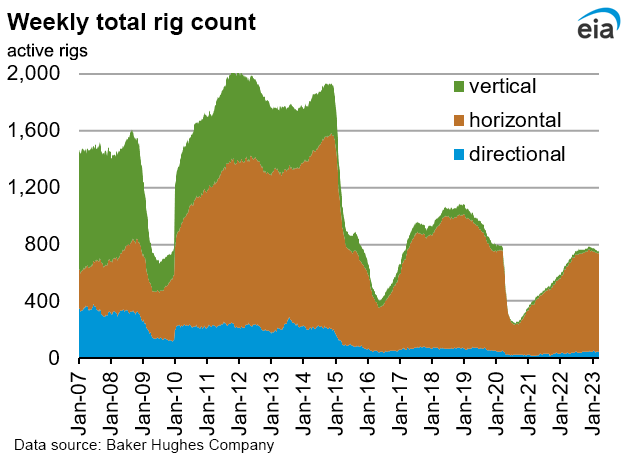
| Rigs | |||
|---|---|---|---|
Tue, March 14, 2023 |
Change from |
||
last week |
last year |
||
| Oil rigs | 589 |
-0.2% |
12.4% |
| Natural gas rigs | 162 |
5.9% |
18.2% |
| Note: Excludes any miscellaneous rigs | |||
| Rig numbers by type | |||
|---|---|---|---|
Tue, March 14, 2023 |
Change from |
||
last week |
last year |
||
| Vertical | 15 |
25.0% |
-28.6% |
| Horizontal | 692 |
0.0% |
14.2% |
| Directional | 47 |
11.9% |
30.6% |
| Data source: Baker Hughes Company | |||
| Working gas in underground storage | ||||
|---|---|---|---|---|
Stocks billion cubic feet (Bcf) |
||||
| Region | 2023-03-17 |
2023-03-10 |
change |
|
| East | 355 |
391 |
-36 |
|
| Midwest | 461 |
490 |
-29 |
|
| Mountain | 84 |
87 |
-3 |
|
| Pacific | 72 |
72 |
0 |
|
| South Central | 927 |
933 |
-6 |
|
| Total | 1,900 |
1,972 |
-72 |
|
| Data source: U.S. Energy Information Administration Form EIA-912, Weekly Underground Natural Gas Storage Report | ||||
| Working gas in underground storage | |||||
|---|---|---|---|---|---|
Historical comparisons |
|||||
Year ago (3/17/22) |
5-year average (2018-2022) |
||||
| Region | Stocks (Bcf) |
% change |
Stocks (Bcf) |
% change |
|
| East | 271 |
31.0 |
299 |
18.7 |
|
| Midwest | 321 |
43.6 |
361 |
27.7 |
|
| Mountain | 87 |
-3.4 |
89 |
-5.6 |
|
| Pacific | 157 |
-54.1 |
163 |
-55.8 |
|
| South Central | 561 |
65.2 |
637 |
45.5 |
|
| Total | 1,396 |
36.1 |
1,549 |
22.7 |
|
| Data source: U.S. Energy Information Administration Form EIA-912, Weekly Underground Natural Gas Storage Report | |||||
| Temperature – heating & cooling degree days (week ending Mar 16) | ||||||||
|---|---|---|---|---|---|---|---|---|
HDDs |
CDDs |
|||||||
| Region | Current total |
Deviation from normal |
Deviation from last year |
Current total |
Deviation from normal |
Deviation from last year |
||
| New England | 199 |
-9 |
12 |
0 |
0 |
0 |
||
| Middle Atlantic | 204 |
11 |
24 |
0 |
0 |
0 |
||
| E N Central | 224 |
21 |
16 |
0 |
0 |
0 |
||
| W N Central | 232 |
29 |
2 |
0 |
-1 |
0 |
||
| South Atlantic | 143 |
28 |
19 |
9 |
-2 |
-3 |
||
| E S Central | 138 |
29 |
8 |
0 |
-4 |
0 |
||
| W S Central | 63 |
-4 |
-34 |
12 |
1 |
8 |
||
| Mountain | 169 |
7 |
-17 |
0 |
-1 |
-1 |
||
| Pacific | 106 |
15 |
22 |
0 |
-1 |
0 |
||
| United States | 168 |
16 |
9 |
3 |
-1 |
0 |
||
|
Data source: National Oceanic and Atmospheric Administration Note: HDDs=heating degree days; CDDs=cooling degree days | ||||||||
Average temperature (°F)
7-day mean ending Mar 16, 2023
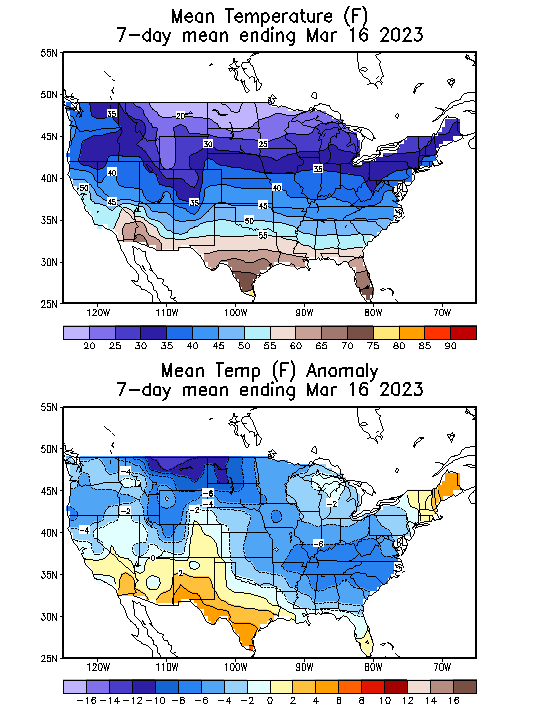
Data source: National Oceanic and Atmospheric Administration
Deviation between average and normal temperature (°F)
7-day mean ending Mar 16, 2023

Data source: National Oceanic and Atmospheric Administration

